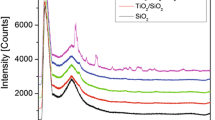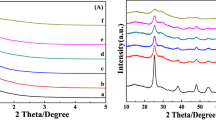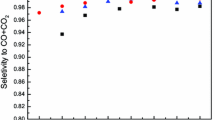Abstract
The dispersion state and catalytic properties of anatase-supported vanadia species are studied by means of X-ray diffraction (XRD), laser Raman spectroscopy (LRS), H2 temperature-programmed reduction (TPR) and the selective oxidation of o-xylene to phthalic anhydride. The almost identical values of the experimental dispersion capacity of V2O5 on anatase and the surface vacant sites available on the preferentially exposed (001) plane of anatase suggest that the highly dispersed vanadium cations are bonded to the vacant sites on the surface of anatase as derived by the incorporation model. When the loading amount of V2O5 is far below its dispersion capacity, the dispersed vanadia species might mainly consist of isolated VOx species bridging to the surface through V-O-Ti bonds. With the increase of V2O5 loading the isolated vanadia species interact with their nearest neighbors (either isolated or polymerized vanadia) through bridging V-O-V at the expenses of V-O-Ti bonds, resulting in the increase of the ratio of polymerized to isolated vanadia species and the decrease of the reactivity of the associated surface oxygen anions and, consequently, although the activity increases with loading to reach a maximum value, the turn over number (TON) of the V2O5/TiO2 catalyst decreases linearly. When the loading amount of V2O5 is higher than its dispersion capacity, the turn over number decreases more rapidly with the increase of V2O5 loading due to the formation of V2O5 crystallites in which the oxygen anions associated with V-O-V bonds are less reactive and only partially exposed on the surface.
Similar content being viewed by others
References
Golinelli, G., Trifirò, F., Selective oxidation of o-xylene to phthalic anhydride over the Eurocat V2O5/TiO2 catalysts, Catalysis Today, 1994,20: 153–164.
Bosch, H., Janssen, F., Catalytic reduction of nitrogen oxides—A review on the fundamentals and technology, Catalysis Today, 1988,2:369–531.
Vejux, A., Courtine, P., Interfacial reactions between V2O5 and TiO2 (anatase): Role of the Structural properties, Journal of Solid State Chemistry, 1978,23: 93–103.
Bond, G. C., Preparation and properties of vanadia/titania monolayer catalysts, Applied Catalysis A: General, 1997, 157: 91–103.
Bond, G. C., Tahir, S. F., Vanadium oxide monolayer catalysts: Preparation, characterization and catalytic activity, Applied Catalysis A: General, 1991, 71: 1–31.
Wachs, I. E., Weckhuysen, B. M., Structure and reactivity of surface vanadium oxide species on oxide supports, Applied Catalysis A: General, 1997, 157: 67–90.
Chen, Y., Zhang, L. F., Surface interaction model of γ-alumina-supported metal oxide, Catal. Lett., 1992, 12: 51–62.
Dong, L., Chen, Y., Study on interaction between ionic compounds and oxide supports—“Incorporation Model” and its application, Chinese Journal of Inorganic Chemistry (in Chinese), 2000, 16(2): 250–260.
Xie, Y. C., Tang, Y. Q., Spontaneous monolayer dispersion of oxides and salts onto surface of supports: Application to heterogenous catalysis, Adv. Catal., 1990,37: 1–43.
Went, T. G., Oyama, S. T., Bell, A. T., Laser Raman spectroscopy of supported vanadium oxide catalysts, J. Phys. Chem., 1990, 94: 4240–4246.
Primet, M., Pichat, P., Mathieu, M. V., Infrared study of the surface of titanium dioxides, J. Phys. Chem., 1971, 75: 1216–1220.
Xu, B., Dong, L., Chen, Y., Influence of CuO loading on dispersion and reduction behavior of CuO/TiO2(anatase) system, J. Chem. Soc., Faraday Trans., 1998, 94: 1905–1909.
Nogier, J. Ph., De Kersabiec, A. M., Fraissard, J., Thermal evolution of a TiO2-V2O5 interface, Applied Catalysis A: General, 1999, 185: 109–121.
Bosch, H., Kip, B. J., Ommen, J. G. et al., Factors influencing the temperature programmed reduction profiles of vanadium pentoxide, J. Chem. Soc., Faraday Trans., 1984, 80: 2479–2488.
Doornkamp, C., Clement, M., Gao, X. et al., The oxygen isotopic exchange reaction on vanadium oxide catalysts, Journal of Catalysis, 1999, 185(2): 415–422.
Author information
Authors and Affiliations
Corresponding author
Rights and permissions
About this article
Cite this article
Xu, B., Fan, Y., Liu, L. et al. Dispersion state and catalytic properties of vanadia species on the surface of V2O5/TiO2 catalysts. Sc. China Ser. B-Chem. 45, 407–415 (2002). https://doi.org/10.1360/02yb9052
Received:
Issue Date:
DOI: https://doi.org/10.1360/02yb9052




